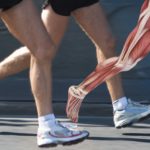
By Shelby Stoner, PHASE IV Exercise Physiologist
“I should stop running until that pain goes away” …Said no runner ever. Guess what? Running through pain is NOT the solution to your problem, especially when it’s persistent. And one of the most common running injuries out there? You guessed it…Shin splints.
It’s the catch-all term for lower leg pain that occurs below the knee either on the front part of the leg or on the inside of the leg. Shin splints affect many people who maintain active lifestyles, and are often the enemy of many runners, tennis players, even dancers! They often plague overtrained runners or those who abruptly change their workout regimen such as switching from running on flat surfaces to hills. Read more about the anatomy and diagnosis of Shin Splints in the following excerpt from Healthy Running Step by Step by Robert Forster, Physical Therapist to Olympic Champions and Roy M. Wallack, Los Angeles Times Fitness Columnist.
Chapter 9: Rehabbing Running Injuries
Shin Splints: Anatomy and Function
An Excerpt from “Healthy Running Step by Step” by Robert Forster, P.T. & Roy M. Wallack
The term shin splints is a catchall phrase that refers to nearly all pain in the lower leg except calf and Achilles tendon injuries. There are two types: anterior shin splints and medial shin splints.
Anterior shin splints appear as pain in the fleshy muscle in the front of the lower leg. Although this injury is common when runners first begin running after a layoff, it is rarely serious or persistent.
Medial shin splints (technically termed a periostitis), which appear on the inside border of the lower leg bone (tibia), are much worse. They occur from overpronation when you run too far too soon, straining tendons that attach to the tibia and pulling the periosteum, the paper-thin tissue covering of all bones, away from the shin bone.
When you move your body forward over a weight- bearing foot, the toes are extended and lifted upward, winding the plantar fascia taut like a skin over a drum. This action helps transform the foot from a flexible structure able to adapt to variations in the walking surface, to a rigid lever that supports the foot while it’s on the ground, by limiting the degree that the arch collapses as the body moves forward over the foot.
A quick anatomy lesson may help explain what’s happening here: Muscles deep in the back of the calf function to slow down the forward progression of the tibia over the foot in the stance phase of running. The tendons of these deep flexor muscles attach either directly to the medial border of the tibia or indirectly by way of tether-like structures. When they fatigue they begin to function poorly, the tendons become in inflamed (tendonitis), and they pull the periosteum covering away from the bone and create acute pain (periostitis).
HOW YOU FEEL THE PAIN
Typically, shin-splint pain will first appear at the end of long runs or after extended efforts. Soon, the pain will appear earlier in the workout and sometimes abate as you warm up, only to return toward the end of the workout. As time goes on, the pain will spill over into walking and standing during activities of daily living. Occasionally, runners will pull up (stop due to pain) during workouts and racing with a complete fracture of the tibia.
HOW THE INJURY HAPPENS
The most common mechanical running error is overstriding. By definition, when you overstride you take too few steps per minute; therefore, your foot spends too much time in contact with the ground during each step. If you are an over- pronator, this extended period on the ground (what we call the stance phase) allows the foot to pronate to a greater degree than it otherwise would with quicker steps. The result is that the deep flexor muscles of the calf remain engaged for just a few milliseconds too long with each step. Mile after mile, this fatigues the muscles. As they begin to operate dysfunctionally, their tendons become damaged, and as they lose their elastic properties, they pull the periosteum off the bone.
REHABILITATION TECHNIQUES
In addition to treating the inflammation in the bones and the tendons with regular icing, it is imperative to break up the scar tissue and build up the muscles deep in the calf with foam roller work while progressing through the stretching and strengthening program.
However, the single most important factor for the resolution of this injury and to prevent re-injury is to increase your running cadence (i.e., increase the number of steps you take per minute).
More steps per minute reduce the amount of time the muscles in the calf have to work each step and limit their load by limiting the degree of pronation. In addition, a light self-grip wrap around the shin bone will provide a compression force to help the periosteum re-adhere to the tibia bone.
If the pain is bilateral (i.e., in both legs), then the causative factors in th e development of the shin splints are both overpronation and over-striding. If the pain is unilateral, then it is likely the painful side is the long leg, which is over-pronating in an effort to even out your leg lengths during weight bearing. This will have to be corrected to resolve the shin splint along with an increase in running cadence.
SUMMARY
If you are running in the upcoming marathon, your shin splints need to be evaluated immediately. Local icing and PT treatment at the painful site will help, but ultimately we need to address cadence, mechanics, and leg length discrepancy for total resolution of the problem. We will fix your injury and teach you prescription stretching and strengthen exercises to correct your alignment and work with you to prevent shin splints.
Call Forster Physical Therapy for your free evaluation: 310-656-8600
P.S Don’t forget to get your own copy of Health Running Step by Step to make sure that you are running strong and healthy for the long run!








